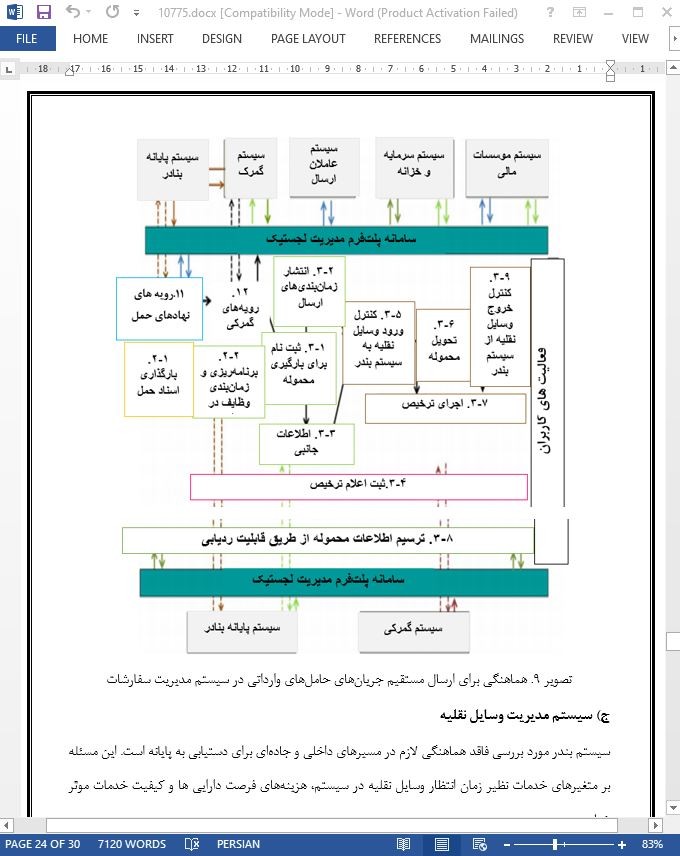
سیستم مشارکتی مدیریت زنجیره تامین برای زنجیره لجستیک دریایی در بنادر
چکیده
در این مقاله نوعی چارچوب مشارکتی لجستیک را برای زنجیره لجستیک بنادر ( پی ال سی) بر اساس اصول مدیریت زنجیره تامین ( اس سی ام) ارائه میکنیم که مبتنی بر همکاری و یکپارچگی ذینفعان بوده و میتوان از آن به عنوان مدلی مرجع در هماهنگیهای زمینی مربوط به زنجیره لجستیک بنادر بهره جست. بدین منظور پیشینه تحقیق بهطور کامل مرور و موارد متعددی تحلیل گردید که در آنها رویههای مدیریت زنجیره تامین به کار گرفته شده بود. همچنین تحقیقات مربوط به توسعه بنادر، حکمرانی، هماهنگی و بهینهگزینی مورد مطالعه قرار گرفت. از این اطلاعات پیشزمینهای برای شناسایی خلاهای موجود در روشهای مدیریت لجستیک و همچنین حوزههای احتمالی استفاده شد که امکان بهکارگیری اصول زنجیره لجستیک بنادر برای طراحی مجدد فرآیندها و شکلدهی به ساختارهای جدید تحت شمایی همکاریجویانه و براساس قواعد مدیریت زنجیره تامین را فراهم میسازد.
1. دیباچه
زنجیره لجستیک بنادر ( پی ال سی) شامل تمامی زنجیرههای لجستیک جهانی است که از طریق یک بندر دریایی عملیات خود را انجام میدهند. این زنجیره تمامی ذینفعان مختلف در فرآیندهای تجارت بینالملل نظیر واردکنندگان و صادرکنندگان، مقامات بندر، گردانندگان ترمینالها، گمرک، ماموران گمرک، شرکتهای حمل و نقل ( زمینی و دریایی)، واسطههای حمل بار، پارکینگهای مخصوص کانتینرها و غیره را دربرمیگیرد.زنجیره لجستیک بنادر در زمینه یکپارچهسازی فرآیندهای زنجیره تامین و همچنین شمار قابلتوجه ذینفعان دولتی و خصوصی با چالشهای بسیاری مواجه است. چالش دیگری که چنین زنجیرههایی با آن دست به گریبانند، وجود منابع متعدد تنوعآفرینی است که بر جریانهای واردات و صادرات اثر میگذارد.
6. نتیجهگیری و پیشنهاد برای تحقیقات آتی
در این تحقیق چارچوب لجستیک مشارکتی در زنجیره لجستیک بنادر بر اساس بهکارگیری اصول مدیریت زنجیره تامین معرفی شد که تحقق آن به بهبود همهجانبه در عملیات شرکتها و یکپارچهسازی فرآیندهای کسب و کار زنجیره لجستیک بنادر با ذینفعان بستگی دارد. این رویکرد جدید را میتوان به عنوان مرجعی برای هماهنگی در زنجیره لجستیک بنادر به لحاظ زیرساختها، منابع مشترک و اطلاعات پشتیبانی کننده از تصمیمات مشارکتی به کار گرفت. چارچوب مشارکتی مذکور شامل سه بعد اصلی است: (الف) مدیریت حکمرانی لجستیک بنادر ؛ (ب) سامانه پلتفرم مدیریت لجستیک و (ج) مدل عملیات لجستیک بنادر. این چارچوب بر طراحی و پیادهسازی سه فرآیند بین سازمانی کسب و کار در زنجیره لجستیک بنادر مبتنی بود: مدیریت تقاضا، مدیریت سفارشات و مدیریت وسایل نقلیه. فرآیندهای مشارکتی مذکور در سطح تاکتیکی ( برنامهریزی و زمانبندی) و عملیاتی ( کنترل و اجرا) تعریف می شود. هدف جهانی این فرآیندها هماهنگی میان منابع مشترک و کاهش نوسانهای عملیاتی است.
Abstract
In this article we propose a collaborative logistics framework for a Port Logistics Chain (PLC) based on the principlesof Supply Chain Management (SCM) that rely on stakeholders integration and collaboration, providing a referencemodel for the inland coordination of the PLC. A comprehensive literature review was conducted, analyzing severalcases in which SCM practices have been implemented as well as studies related to port development, governance,coordination and best practices associated. This background information was used to identify current gaps in logisticsmanagement practices and potential scopes of intervention within the PLC to suggest a redesign process andconfigure new structures under a collaborative scheme, following the guidelines of SCM.
1. Introduction
A port logistics chain (PLC) embraces all the global logistics chains that operate through a seaport, including different stakeholders involved in the international trade processes, such as the importers and exporters, the Port Authority, the terminal operators, customs, customs agents, transport companies (ground and maritime), freight forwarders, empty container parks, etc. The PLC faces important challenges for the integration of those supply chains processes and the huge number of public and private stakeholders. Another challenge faced by the PLC is the existence of several sources of variability that affect the import and export flows.
6. Conclusiones and Recommendations for further research
A Collaborative Logistics Framework for a port logistics chain is presented based on the application of SCM principles that rely on an integral improvement of the multi-enterprise operations, based on the integration of the business processes of the PLC with its stakeholders. This new approach aims to provide a reference model for the coordination of the PLC in terms of infrastructure, common resources, and the information that supports collaborative decisions making. The proposed collaborative framework comprises three main dimensions: the Management of Port Logistic Governance, (b) the Logistics Management Platform System (LPMS) and (c) the Port Logistics Operations Model. The framework is focused on the design and implementation of the three inter-enterprise business processes of the PLC: demand management, orders management, and vehicles management. These collaborative processes are developed at a tactical (planning and scheduling) and operational (control and execution) levels. The global objective of these inter-enterprise processes is the coordination of common resources and the reduction of operational variability.

چکیده
1. دیباچه
2. پیشینه تحقیق
3. شرحی بر چارچوب لجستیک مشارکتی
4. شرحی بر سامانه پلتفرم مدیریت لجستیک (ال ام پی اس)
4-1. فرآیندهای بینسازمانی در زنجیره لجستیک بنادر
4-2. پلتفرم فناورانه برای سامانه مدیریت لجستیک
5. موردکاوی در خصوص بهکارگیری چارچوب مشارکتی در زنجیره لجستیک بنادر در شیلی
مدیریت حکمرانی لجستیک بنادر
مدل عملیات لجستیک بنادر
سامانه پلتفرم مدیریت لجستیک
6. نتیجهگیری و پیشنهاد برای تحقیقات آتی
ABSTRACT
1. Introduction
2. Literature Review
3. Collaborative Logistics Framework Description
4. Logistics Management Platform System (LMPS) description.
4.1 Inter-Enterprise processes of the PLC
4.2 Technological Platform for the LMPS
5._Case Study of an application of the Collaborative Framework for a Chilean port logistics chain.
Management of Port Logistics Governance
Port Logistics Operations Model
Logistics Management Platform System
6. Conclusiones and Recommendations for further research
- اصل مقاله انگلیسی با فرمت ورد (word) با قابلیت ویرایش
- ترجمه فارسی مقاله با فرمت ورد (word) با قابلیت ویرایش، بدون آرم سایت ای ترجمه
- ترجمه فارسی مقاله با فرمت pdf، بدون آرم سایت ای ترجمه
